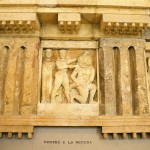Remember back in July when the Italian government declared Pompeii to be in a “State of Emergency”? At the time, I quoted them saying this:
The “state of emergency”, which the government said would last for a year, allows for extra funds and special measures to be taken to protect the site.
Makes sense, I thought. It’s about time, I thought. Pompeii needs all the extra funds and special measures it can get. Turns out my idea of extra funds and special measures differ drastically from the current Italian government’s.
My idea of extra funds is additional moneys added to the budget. Berlusconi’s idea of extra funds is slashing Pompeii’s preservation budget from $75 million last year to $15 million this year.
My idea of special measures is additional security and expanding the area under active preservation. The government’s idea is to rent space in the ruins of an ancient villa in downtown Pompeii for a theme restaurant.
Guzzo said he at first was unable to explain why—now—the Culture Ministry found Pompeii in sudden distress. Then he realized the attention was not on the ruins themselves.
The emergency was declared days before the Berlusconi government took aim at another financial woe — the nation’s sagging economy.
All arts and restoration funds were frozen, and more than $1.3 billion was slashed from Italy’s culture budget for the next three years.
In other words, that state of emergency thing was a ruse, some PR misdirection crap to make a decimation of government support look like a heroic defense. I’m so angry I could spit.





